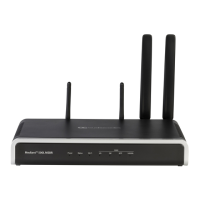User's Manual 29. Configuring Supplementary Services
Version 6.8 479 Mediant 500L MSBR
Parameter Description
User Password
CLI: user-password
[ISDNSuppServ_UserPassword]
Defines the user password
for registering the endpoint
to a third-party softswitch for authentication and/or
billing.
Note: For security, the password is displayed as an
asterisk (*).
Caller ID Name
CLI: caller-id-number
[ISDNSuppServ_CallerID]
Defines the caller ID name of the endpoint (sent to the
IP side).
The valid value is a string of up to 18 characters.
Presentation Restricted
CLI: presentation-restricted
[ISDNSuppServ_IsPresentationRestricted]
Determines whether the endpoint sends its Caller ID
information to the IP when a call is made.
[0] Allowed = The device sends the string defined
in the 'Caller ID' field when this endpoint makes a
Tel-to-IP call.
[1] Restricted = The string defined in the 'Caller ID'
field is not sent.
Caller ID Enabled
CLI: caller-id-enable
[ISDNSuppServ_IsCallerIDEnabled]
Enables the receipt of Caller ID.
[0] Disabled = The device does not send Caller ID
information to the endpoint.
[1] Enabled = The device sends Caller ID
information to the endpoint.
29.15 Detecting Collect Calls
The device detects collect calls (reverse charge calls) using any of the following
information elements (IE) in the received Q.931 ISDN Setup message for Tel-to-IP calls:
Reverse Charging Indication IE
Facility IE
When the device detects a collect call, it adds a proprietary header (X-Siemens-Call-Type:
collect call) to the outgoing SIP INVITE message.
This support does not require any configuration and is applicable to the Euro ISDN protocol
variant.
29.16 Advice of Charge Services for Euro ISDN
Advice of charge (AOC) is a pre-billing function that tasks the rating engine with calculating
the cost of using a service and relaying that information back to the customer (caller). This
allows users to obtain call charging information periodically - during the call (AOC-D) and at
the end of the call (AOC-E).
The AOC messages are sent in the EURO ISDN Facility Information Element (IE)
message. The device interworks these ISDN messages with SIP by converting the AOC
messages into SIP INFO (during call) and BYE messages (end of call), using AudioCodes
proprietary SIP AOC header, and vice versa. The device supports both currency (monetary
units) and pulse (non-monetary units) AOC messages.
This feature can typically be implemented in the hotel industry, where external calls made
by guests can be billed accurately. In such a setup, the device is connected on one side to
a PBX through an ISDN line (Euro ISDN), and on the other side to a SIP trunk provided by
an ITSP. When a call is made by a guest, the device first sends an AOC-D Facility
message to the PBX indicating the connection charge unit, and then sends subsequent
AOC-D messages every user-defined interval to indicate the charge unit during the call.





